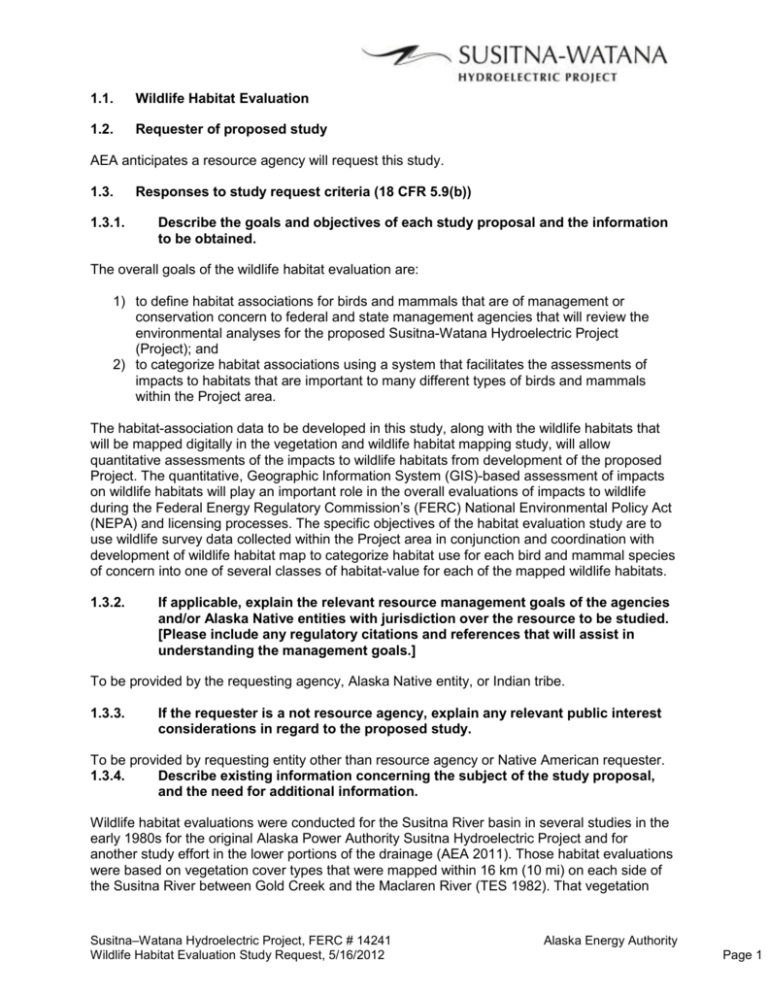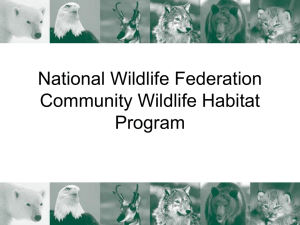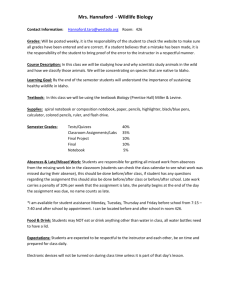Wildlife Habitat Evaluation (Redline) - Susitna
advertisement

1.1. Wildlife Habitat Evaluation 1.2. Requester of proposed study AEA anticipates a resource agency will request this study. 1.3. 1.3.1. Responses to study request criteria (18 CFR 5.9(b)) Describe the goals and objectives of each study proposal and the information to be obtained. The overall goals of the wildlife habitat evaluation are: 1) to define habitat associations for birds and mammals that are of management or conservation concern to federal and state management agencies that will review the environmental analyses for the proposed Susitna-Watana Hydroelectric Project (Project); and 2) to categorize habitat associations using a system that facilitates the assessments of impacts to habitats that are important to many different types of birds and mammals within the Project area. The habitat-association data to be developed in this study, along with the wildlife habitats that will be mapped digitally in the vegetation and wildlife habitat mapping study, will allow quantitative assessments of the impacts to wildlife habitats from development of the proposed Project. The quantitative, Geographic Information System (GIS)-based assessment of impacts on wildlife habitats will play an important role in the overall evaluations of impacts to wildlife during the Federal Energy Regulatory Commission’s (FERC) National Environmental Policy Act (NEPA) and licensing processes. The specific objectives of the habitat evaluation study are to use wildlife survey data collected within the Project area in conjunction and coordination with development of wildlife habitat map to categorize habitat use for each bird and mammal species of concern into one of several classes of habitat-value for each of the mapped wildlife habitats. 1.3.2. If applicable, explain the relevant resource management goals of the agencies and/or Alaska Native entities with jurisdiction over the resource to be studied. [Please include any regulatory citations and references that will assist in understanding the management goals.] To be provided by the requesting agency, Alaska Native entity, or Indian tribe. 1.3.3. If the requester is a not resource agency, explain any relevant public interest considerations in regard to the proposed study. To be provided by requesting entity other than resource agency or Native American requester. 1.3.4. Describe existing information concerning the subject of the study proposal, and the need for additional information. Wildlife habitat evaluations were conducted for the Susitna River basin in several studies in the early 1980s for the original Alaska Power Authority Susitna Hydroelectric Project and for another study effort in the lower portions of the drainage (AEA 2011). Those habitat evaluations were based on vegetation cover types that were mapped within 16 km (10 mi) on each side of the Susitna River between Gold Creek and the Maclaren River (TES 1982). That vegetation Susitna–Watana Hydroelectric Project, FERC # 14241 Wildlife Habitat Evaluation Study Request, 5/16/2012 Alaska Energy Authority Page 1 mapping was conducted over 30 years ago and the subsequent habitat evaluations were conducted at least 27 years ago. Both the vegetation mapping and the habitat evaluation should be updated for the current Project. The wildlife habitat evaluations completed in the early 1980s were based on vegetation types, not wildlife habitat types. Wildlife habitat maps provide land cover classifications that are better suited to evaluations of habitat use by birds and mammals than a vegetation map alone through the incorporation of vegetation structure and landform information. Wildlife habitat use can be influenced by the density of animals with a larger variety of habitats used when animal densities are high. In addition, vegetation cover, structure, and landforms are likely to have changed to some degree within the Project area due to landslides, erosion, thermokarst, fire, forest succession, expansion/contraction/decadence of birch and aspen clones, and increases in woody shrubs associated with increased summer temperatures. To provide current and accurate information for assessing the impacts of habitat loss and alteration for wildlife during the FERC licensing process, it will be necessary to update wildlife habitat evaluations proposed Project, and that those habitat evaluations are based on current wildlife habitat maps for the Susitna River basin. 1.3.5. Explain any nexus between project operations and effects (direct, indirect, and/or cumulative) on the resource to be studied, and how the study results would inform the development of license requirements. Wildlife would be primarily affected by the loss and alteration of their preferred habitats, but would also potentially be disturbance and displacement during Project construction and operations. Habitat loss and alteration and disturbance/displacement effects are often treated as indirect impacts. Direct impacts to birds and mammals could occur from mortality or injury during collisions with transmission lines or vehicles and from the possible ingestion of contaminants from accidental spills of petroleum products or other contaminants. Cumulative impacts on birds and mammals could occur from extensive loss and alteration of habitats, including fragmentation of habitats, in areas that have already undergone some development. Regional cumulative effects, however, are unlikely to be extensive because the proposed Project is located in a remote area where the primary developments include a few small lodge operations and dispersed remote dwellings. The results of the wildlife habitat evaluation study would provide current information on the expected use of mapped wildlife habitats for birds and mammals of concerning the Project area and would, in coordination and conjunction with wildlife habitat mapping, facilitate quantitative assessments of the loss and alteration of important wildlife habitats due to construction and operation of the proposed Project. Current information on the habitat use of birds and mammals, which would be derived in this study, will be critical to the accurate assessment of impacts to birds and mammals during the FERC licensing process. 1.3.6. Explain how any proposed study methodology (including any preferred data collection and analysis techniques, or objectively quantified information, and a schedule including appropriate field season(s) and the duration) is consistent with generally accepted practice in the scientific community or, as appropriate, considers relevant tribal values and knowledge. The proposed methods for the wildlife habitat evaluation study involve the use of current and Project-specific survey data for birds and mammals in coordination and conjunction with the Susitna–Watana Hydroelectric Project, FERC # 14241 Wildlife Habitat Evaluation Study Request, 5/16/2012 Alaska Energy Authority Page 2 preparation of a current wildlife habitat map for the Project area. This study would be an officebased effort, performed after the wildlife habitat mapping for the Project area is completed. The first task in the wildlife habitat evaluation study is the selection of a set of birds and mammals of concern, which would be assessed for habitat impacts for the Project. The procedure for determining which animals are included will be made with input from federal and state management agencies during development of the formal 2013–2014 FERC study plans for wildlife. Criteria will be established for the species-selection process, and it is likely that a species will be selected if it meets one or more of the following criteria: 1) a federal or state-protected species; 2) a species of conservation concern as determined by various management agencies, agency working groups, and non-governmental conservation organizations (FERC and USFWS 2011); 3) a species of management concern for federal and/or state management agencies, 4) a sensitive species, which can reflect environmental effects through changes in distribution and/or abundance; or 5) an ecologically important species (such as a prominent predator or prey species or one with demonstrable ecosystem effects). For each species of concern selected and for each wildlife habitat type mapped in the Project area, a habitat-value ranking will be assessed. As with the species-selection process, this procedure will be developed with input from federal and state management agencies during preparation of the formal 2013–2014 FERC study plans for wildlife, but it is likely that a simplified habitat-value categorization system would be used (e.g., negligible, low, moderate, and high). The habitat-value rankings for various bird and mammal groups will be derived in different ways depending on the level of Project-specific data that are available to assess habitat use within each of the mapped wildlife habitat types. Observations of wildlife species will be tagged to mapped habitats in a GIS and the data quality will be assessed for each species and mapped habitat type (e.g., adequately sampled, undersampled, or not sampled). Quantitative evaluations of the observations of the use of mapped habitats will be used whenever possible to discern rankings among the habitat-value categories used, but in cases in which the habitats in question were under sampled or not sampled, habitat-use information from the scientific literature and/or from field experience with the species will be used to derive habitat-value rankings. Specific habitat-use maps can be prepared for high-value game animals such as caribou, moose, and bears, that will illustrate specific use areas and periods in addition to the identification of habitats that are important to a wide variety of wildlife.. 1.3.7. Describe considerations of level of effort and cost, as applicable, and why any proposed alternative studies would not be sufficient to meet the stated information needs. The wildlife habitat evaluation would be an office-based study only and likely could be completed in several months, depending on the size of the area that will be mapped for wildlife habitats, which will be determined in consultation with agency reviewers. The habitat evaluation study would be conducted by up to 2 vegetation ecologists and 4 wildlife biologists with specific expertise with various bird and mammal species groups. The cost for this office-based study is expected to be relatively small in relation to the benefits that will be derived by facilitating a coordinated, GIS-based assessment of Project impacts on bird and mammal habitats. Susitna–Watana Hydroelectric Project, FERC # 14241 Wildlife Habitat Evaluation Study Request, 5/16/2012 Alaska Energy Authority Page 3 1.3.8. Literature Cited AEA (Alaska Energy Authority). 2011. Pre-Application Document: Susitna-Watana Hydroelectric Project FERC Project No. 14241. December 2011. Prepared for the Federal Energy Regulatory Commission by the Alaska Energy Authority, Anchorage, Alaska. FERC (Federal Energy Regulatory Commission) and USFWS (U.S. Fish and Wildlife Service). 2011. Memorandum of Understanding between the Federal Energy Regulatory Commission and the U.S. Department of the Interior, United States Fish and Wildlife Service, Regarding Implementation of Executive Order 13186, “Responsibilities of Federal Agencies to Protect Migratory Birds.” March 2011. 13 pp. TES (Terrestrial Environmental Specialists). 1982. Susitna Hydroelectric Project, Task 7— Environmental studies, wildlife ecology: wildlife habitat-value analysis. Report prepared by Terrestrial Environmental Specialists, Inc., Phoenix, NY, for Acres American, Inc., Buffalo, NY. 100 pp. Susitna–Watana Hydroelectric Project, FERC # 14241 Wildlife Habitat Evaluation Study Request, 5/16/2012 Alaska Energy Authority Page 4








